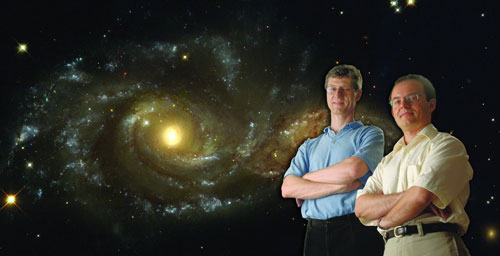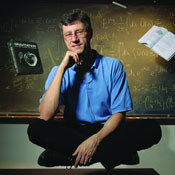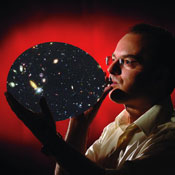
 Physicists Luca Bombelli (left) and Marco Cavaglia are helping stretch the boundaries of understanding about the nature of the universe through differently modeled projects.
Physicists Luca Bombelli (left) and Marco Cavaglia are helping stretch the boundaries of understanding about the nature of the universe through differently modeled projects.
Cavaglia and fellow professor Luca Bombelli are not so pessimistic. They are on a quest. If more dimensions are there, they intend to find them.
Both UM physicists are seeking out new properties of time and space with differently modeled studies. Bombelli’s research model presumes there are no other dimensions; Cavaglia’s model presumes there are—two approaches in search of reality.
Both projects were sufficiently intriguing to earn Faculty Research Awards this year from the university’s Office of Research and Sponsored Programs.
“Some scientists believe there could be up to seven undiscovered dimensions,” Cavaglia says, holding a flat sheet of paper. “At one time, the thickness of this paper was very hard to discern with the instruments we had, but we knew it was there. Today, powerful microscopes allow us to see it and even measure it.”
He curves and bends the paper in various ways, then rolls it into a cylinder, as he speaks. “We can reasonably contemplate that there may be other dimensions that are very small and curved, and that we can see them just briefly during the collisions of microscopic matter particles, which is a constant activity in the universe. Perhaps we can observe and study them for the first time.”
That reality will be driven by the massive new-generation Large Hadron Collider (LHC), which should be operational at the European Center for Nuclear Research, or CERN, in Geneva, Switzerland, in two years. Sometimes called an “atom smasher,” it will be 10 times more powerful than the world’s largest collider, which now operates in an underground structure at Fermilab in Batavia, Ill. The circular ring of the new collider will have a circumference of 27 kilometers.
Cavaglia explains that scientists believe all visible matter in the universe is made from a few elementary matter particles. With its enormous concentration of energy, the CERN collider should reproduce these particle collisions and seek to re-create the big-bang forces scientists theorize created everything in the universe.
This underground behemoth of technology stands to empower an amazing array of new discoveries about the forces of time and space, including mini black holes.
Like the modest one-dollar bet potentially involving one of the greatest discoveries ever, the UM research is an exercise in massive-minute contrasts. Black holes can be tiny or massive. Perhaps dimensions can be tiny as well.
 Luca Bombelli speculates that the future of quantum physics will be ‘both simpler and more bizarre than what we normally think.’
Luca Bombelli speculates that the future of quantum physics will be ‘both simpler and more bizarre than what we normally think.’
As background, Bombelli explains that the larger black holes of space are created by the collapse of stars, and they develop a gravitational power so strong that even light can’t escape their grip. Even more massive ones are seen at the center of most galaxies. While the very dense “hole” is pulling more matter into it, devouring it and becoming ever larger, scientists also believe it is evaporating at the same time.
“However, we are studying the processes of mini black holes that aren’t created in this way,” Bombelli says. “They are actually far more difficult to study because smaller amounts of matter don’t have the same tendency to collapse, and the ones produced in these high-energy collisions evaporate very quickly.
“And while difficult to study, they are a lot more productive in finding the connection between gravity and quantum theory, which is related to the fundamental structure of time and space. That’s why we want to simulate these processes with computers, and then actually produce them in the particle collider.”
UM’s gravitational theory team is on the leading edge in computer simulation of mini black holes. The team is studying the creation of black holes and the changes they undergo within their life spans, hoping to find better methods to detect and study them.
Cavaglia describes the projects as capturing tiny moments of opportunity. “We believe that mini black holes are being constantly created in Earth’s atmosphere by collisions of high-energy particles, or cosmic rays,” he says. “As we simulate these collisions in the computer, we believe there is just a tiny moment of impact in which new dimensions may be seen, somehow folded and hidden within the process.”
In two years or so, the UM physicists will be poised to deliver their simulations into the massive new particle collider at CERN and see how they compare to the real activity.
Gravitational theorists must naturally be absorbed with black holes because they are gravity power centers. But the work is complementary to other parts of UM physics research and the rest of a strong, coordinated research team that is growing.
Last fall, a new visiting professor and a new research scholar joined the faculty, expanding the department into more studies of the cosmology of the universe, which involves its birth and evolution.
Cavaglia notes that cosmologists are strongly concerned with a recent discovery relating to the big-bang theory. With that theoretical burst of initial creation, the expected aftermath would be a continuous slowing-down process as with an explosion. Yet scientists have been surprised to discover that the universe isn’t slowing down at all but is actually speeding along ever faster, pulling apart. Will this continue?
“Put some dots on a balloon,” Cavaglia says. “Then blow up the balloon and see that the dots are growing farther apart. This is what we see happening in the evolution of space in our universe.”
Research at Ole Miss also is expanding in the related field of astrophysics, the detailed study of ultrahigh energy cosmic rays, which propagate in space and are of unknown origin and composition. “Future research will focus on highest energy particle showers, with new generation equipment that can see them and help understand their origin,” Cavaglia says.
Bombelli notes also that core UM research continues on Einstein’s general relativity theories, which are essentially deterministic, as well as on the probability-based studies within quantum gravity theories. “Quantum theories are being developed in order to understand fluctuations of the small-scale structure of time and space,” he says.
Bombelli, an Italian citizen born in Switzerland, has degrees from the University of Milano in Italy and Syracuse University. He did postdoctoral work in Canada, Austria, Belgium and Switzerland before coming to UM in 1999.
Also an Italian citizen, Cavaglia earned his Ph.D. at the International School for Advanced Studies in Trieste, Italy. He has taught and conducted research at prestigious institutions in Portugal, Germany and the United Kingdom, as well as at M.I.T. and Tufts University.
 The universe is like a giant balloon, with stars, galaxies and other objects scattered through it like dots on the surface of the balloon, Marco Cavaglia says. Physicists are trying to understand why the universe’s expansion seems to be accelerating rather than slowing down, as predicted by most models.
The universe is like a giant balloon, with stars, galaxies and other objects scattered through it like dots on the surface of the balloon, Marco Cavaglia says. Physicists are trying to understand why the universe’s expansion seems to be accelerating rather than slowing down, as predicted by most models.
Both professors have published widely, and when Cavaglia arrived on campus in 2004, he brought with him the experience of co-developing and hosting three international conferences on quantum gravity.
“With the influx of so many new researchers into quantum gravity, there was need for a world forum to discuss the various models and theories that were coming forth,” Cavaglia says. A fourth international gathering took place Sept. 12-16, 2005, in Sardinia, Italy, with UM co-sponsoring. Cavaglia would like to coordinate such a worldwide event on the Ole Miss campus.
Perhaps such a gathering might happen in 2012, when a yellowed envelope with two dollar bills inside can be ceremoniously opened. Whatever the outcome of the bet, Bombelli and Cavaglia are certain that a number of new and amazing discoveries about time and space will be announced between now and then, with the LHC slated to come online in 2008, and far beyond, with other emerging facilities. These include the Laser Interferometer Space Antenna, with three spacecraft orbiting the sun alongside Earth, due to be in service within 10 years.
With this growth in interest and resources, the discovery of a few small and curved formerly hidden dimensions may not be as startling when it happens as it now would seem. “We are on the verge of some truly amazing discoveries and even greater mysteries,” Cavaglia says.
Bombelli speculates about an amazing future. “I would bet that, when we get down to the smallest scales in the universe, dimensions won’t be the real issue. It will be both simpler and more bizarre than what we normally think.”
He picks up Cavaglia’s rolled-up paper cylinder. “From a distance, we might only see its length, a dimension similar to the four dimensions we ordinarily see. Like Marco said, we can see it being stretched or folded, just like space-time can be warped by gravity. We might also see it has a pattern of colors or lines, like the various types of matter.
“Then you look closer, and two things might happen. You can see that it has a thickness that can be rolled into an ‘extra dimension,’ or you might notice that the paper is made up of a huge number of tightly packed fibers. If this is true in space-time, then what kind of fibers are they? How are they held together? Is there a variety of matter and radiation in the universe because there are different kinds of fibers, or because of the way they are woven together, or is it something entirely different?”
Both physicists believe a detailed study of mini black holes will bring a lot of answers.
And even beyond new dimensions, and the mesmerizing questions and challenges presented by both massive and mini black holes, new challenges await.
“If the universe is moving increasingly faster, there is some kind of power behind it, what scientists now recognize simply as dark energy,” Cavaglia says. “As little as we know about mini and massive black holes, we know less about this.”
And then there is what is called dark matter, also present in each galaxy and between galaxies.
“We must understand from the outset that we can only see a very tiny percentage of the matter that exists in the universe,” Cavaglia says. “But we know that it’s there because of its gravitational effects. This dark matter is totally invisible to us. In the context of space, there might be only a small particle every several miles, but stretching over and occupying an inconceivably vast amount of space.”
Given the potential for research on black holes and dark mysteries, and the growing global and space outreach resources to do it, it is timely that physicists ramp up their research. In the years while those dollar bills hang on the board, the university’s physics research team will be on the global forefront of gravitational research, with more new projects coming online.
And if there is discovery of new, previously hidden dimensions with this research, be they even tiny, curved and seen only temporarily during collisions, Cavaglia will be an adjusted-value U.S. dollar richer. This would, no doubt, be the least of his rewards.
Beyond all possible dollars, the greater value from vital physics research will be in significant knowledge breakthroughs that will enable humankind to understand and more fully control or cooperate with the intricately complex forces of the universe—finding more dimensions, more kinds of energy, more vast or small cosmic structures and, yes, more new questions that they didn’t even know they had.